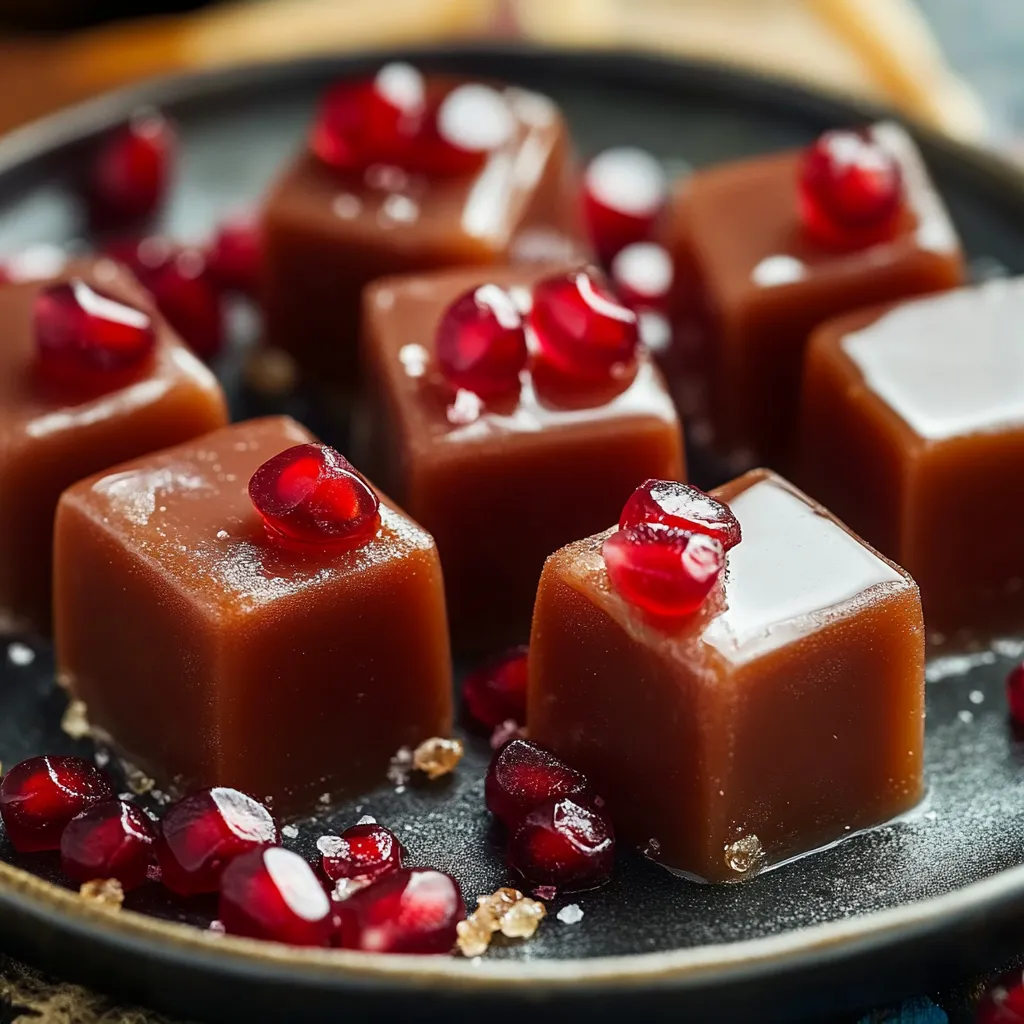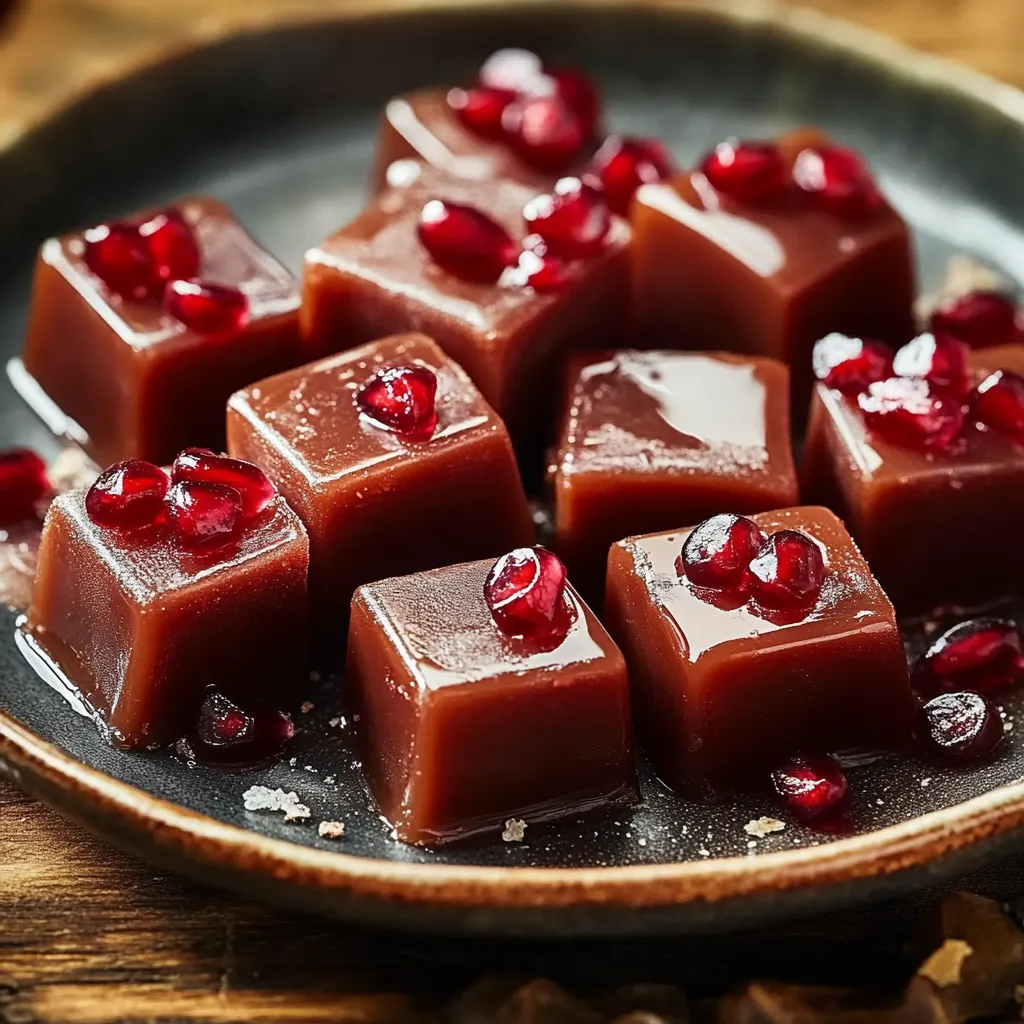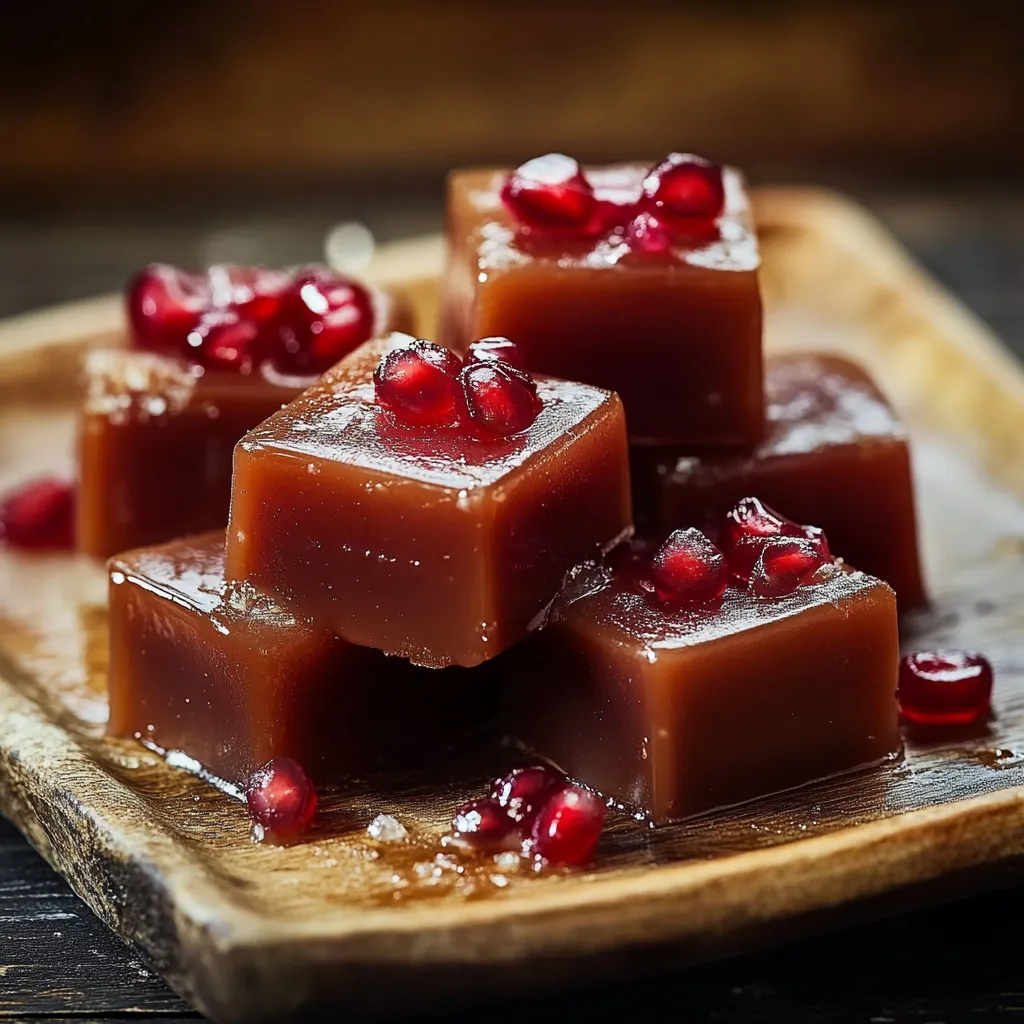 Pin it
Pin it
This pomegranate caramel recipe transforms the vibrant flavor of pomegranate into soft, chewy candies that balance sweet and tart perfectly. The reduction process concentrates the fruit's essence into jewel-toned treats that make wonderful gifts or special after-dinner indulgences.
I discovered this recipe while trying to preserve the last of fall's pomegranates one year. What started as an experiment has become my signature holiday gift that friends now request months in advance.
Ingredients
- Pomegranate juice: Pure not from concentrate ensures the most authentic flavor
- Butter: Adds richness and helps create that perfect chewy texture
- Granulated sugar: Provides the foundation sweetness for proper crystallization
- Light brown sugar: Contributes caramel notes and depth of flavor
- Heavy whipping cream: Creates the silky mouthfeel that defines great caramels
- Vanilla paste: Contains visible vanilla bean specks for gourmet appearance
- Flaky sea salt: Enhances all the flavors while providing occasional crunchy bursts
- Red food coloring: Entirely optional but intensifies the ruby hue if desired
Step-by-Step Instructions
- Reduce the Pomegranate Juice:
- Start with the pomegranate reduction which requires patience. Simmer gently for about an hour watching as four cups transforms into just half a cup of intensely flavored syrup. The reduction should coat the back of a spoon and have a molasses like consistency. This concentrated essence provides the distinctive fruity tang that makes these caramels special.
- Prepare Your Pan:
- While the juice reduces prepare your pan meticulously. The parchment paper sling is crucial for easy removal later. Ensure the paper extends up all sides of the pan creating handles. This attention to detail prevents heartbreak when trying to remove set caramel.
- Create the Caramel Base:
- Combining the reduced pomegranate syrup with butter and sugars requires careful temperature monitoring. The magic happens at precisely 240°F the soft ball stage where the caramel will set firm enough to hold shape but remain pleasantly chewy. Use a reliable candy thermometer and look for a deep burgundy color developing.
- Add Flavor Enhancers:
- Incorporating vanilla and salt off heat preserves their delicate flavors. These additions transform a good caramel into an exceptional one adding complexity and preventing the sweetness from becoming overwhelming. The optional food coloring helps maintain visual appeal especially if your pomegranate reduction ended up darker rather than vibrant red.
- Set and Cut:
- Allow the caramel to cool completely undisturbed before attempting to cut. Use a sharp knife lightly oiled to prevent sticking. Clean the knife between cuts for the most professional appearance. The caramel should have a slight give but hold its shape firmly.
 Pin it
Pin it
My grandmother always said the secret to exceptional caramels is in the details. She would test the temperature in three spots before removing from heat and insisted on using room temperature butter never melted. These little nuances make all the difference in the final product.
Storage Secrets
Properly wrapped pomegranate caramels stay fresh for up to three weeks at room temperature. Store them in an airtight container with parchment between layers to prevent sticking. For longer storage refrigerate for up to two months though allow them to come to room temperature before eating for the best texture experience. Freezing is possible for up to six months with minimal texture changes after thawing.
Troubleshooting Common Issues
If your caramels turn out too soft you likely removed them from heat before reaching the proper temperature. Conversely too hard indicates overheating. Weather can affect candy making with humidity causing longer cooking times and drier conditions requiring vigilance against overheating. For grainy caramels the likely culprit is sugar crystallization caused by stirring too vigorously or sudden temperature changes.
Elegant Variations
Transform these caramels by dipping half in dark chocolate for sophisticated contrast. Add a quarter teaspoon of cardamom or cinnamon to the mixture for a warming holiday flavor profile. For special occasions press a single gold leaf flake onto each caramel before wrapping. During summer months try this recipe with concentrated blackberry juice instead of pomegranate for a seasonal twist.
 Pin it
Pin it
These jewel-toned caramels are the perfect sweet indulgence for any occasion and showcase the beauty of seasonal fruit in a truly gourmet way.
Frequently Asked Questions
- → How long will these pomegranate caramels stay fresh?
When properly wrapped in wax paper and stored in an airtight container, these caramels will stay fresh for 2-3 weeks at room temperature. For longer storage, you can refrigerate them for up to 1 month, though they may become slightly firmer.
- → Can I use bottled pomegranate juice instead of fresh?
Yes, you can use bottled 100% pure pomegranate juice. Just ensure it doesn't contain added sugars or other ingredients that might affect the reduction process and final flavor. Pure, unsweetened pomegranate juice works best.
- → What can I do if my caramels are too soft or too hard?
If your caramels are too soft, you likely didn't reach the proper temperature (240°F). For future batches, ensure your candy thermometer is accurate and cook the mixture slightly longer. If they're too hard, the mixture was probably cooked beyond 240°F. Cooking to a lower temperature next time will yield softer caramels.
- → Can I add different flavors to these caramels?
Absolutely! Consider adding orange zest, cardamom, cinnamon, or a splash of bourbon for interesting variations. You can also experiment with different extracts like almond or orange instead of vanilla. Add these flavorings when you incorporate the vanilla and salt.
- → Is it necessary to use a candy thermometer for this recipe?
A candy thermometer is highly recommended for precision. Without it, it's difficult to know when the caramel reaches the exact soft-ball stage (240°F) needed for the perfect chewy texture. If you don't have a candy thermometer, you can use the cold water test: drop a small amount of the hot caramel into cold water, and it should form a soft, flexible ball when ready.
- → Can I substitute the heavy cream with a non-dairy alternative?
Yes, you can use full-fat coconut cream as a substitute for heavy cream. The high fat content is important for the caramel's texture and setting properties. Other non-dairy milks may not have enough fat, which could result in caramels that don't set properly.
